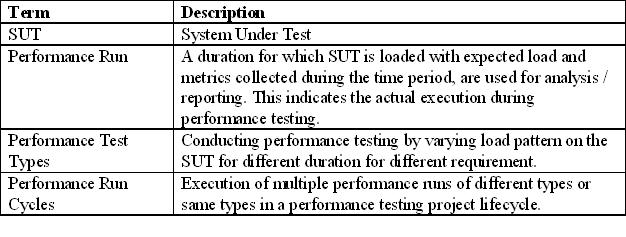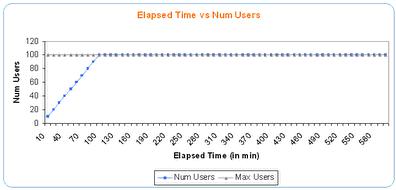10 Different Types of Performance Testing You Should Know
|
Listen on the go!
|
The target audiences for this article are product managers, project managers, performance test engineers and anyone who cares about identifying performance issues in their application(s) before releasing it to market.
This article helps users identify the correct types of performance testing that need to be conducted on their applications.
Frequent application releases are now essential for business survival, making their performance and ability to handle anticipated loads crucial. How well they perform under expected conditions significantly impacts their success. This is where load testing software and types of performance testing come into the picture.
Bringing quality products to the market quickly also makes software testing challenging. Because of the high cost involved in infrastructure, skill set, duration, etc., in non-functional testing, outsourcing it to other organizations usually makes business sense if done correctly.
What is Performance Testing? What is its Significance?
Performance testing is conducted to mitigate the risk of system availability, reliability, scalability, responsiveness, stability, etc. Like any other testing project, it involves many activities.
A few of the important activities involved in any performance testing project are the identification of important business scenarios, identification of correct business scenarios mix, identification of correct workload, identification of the right tools/strategy for load generation, setting up the test environment, designing the scripts for emulating business scenarios, preparing and populating the right amount of data, identification of proper performance counters/metrics to collect, designing the report template(s) for different stakeholders as per their need and execution of multiple performance runs as per the project requirement.
There are many types of performance testing that can be conducted on any application/system. The type of test or run depends upon the performance requirements. In this article, I have listed the importance of various performance test types from technical and business perspectives, which can be considered during multiple stages of performance testing projects.
The definitions of run types might differ from other sources, but the idea is not to define but to logically divide or categorize the performance runs. Saying this, I have tried my best to adhere to the definition as closely as possible from other sources.
The categories are defined in terms of different performance run cycles in any performance testing project. For example, a load run in a project might be performed first and a soak/endurance testing run (with the same workload) later if required.
The following is a summary of ten different types of performance testing that can be referred to and selected according to business requirements. The details of these performance test types are described in their corresponding sections below.
| S.No. | Performance Test Type | Description | Business Case | Performance Testing Life Cycle Stage |
| 1 | Single User | It is conducted for assessing the performance of the application when only a single user is accessing the system. | It helps in improving the performance based on set of pre-existing rules for high performance web pages. | Performance testing life cycle is conducted during the script design phase or as a separate activity. For example, in the case of web applications, tools like YSlow, HttpAnalyzer etc. are used for analyzing the performance of the application. |
| 2 | Contention | It is conducted for validating if application works perfectly when it is accessed concurrently. | Conducting this type of test at the early stage of the development life cycles identifies concurrency issues at initial stages and helps in setting up the environment for performance testing early rather than during release time. | It is conducted during script design phase of the performance testing life cycle, |
| 3 | Light Load | It is conducted for validating the performance characteristics of the system when subjected to workload / load volume much less than what is anticipated during the production load. | Conducting this type of test at the last stage of development life cycles identifies easy to find performance issues early rather than during release time. | It is conducted as a smoke test during the performance testing life cycle |
| 4 | Load | It is conducted for validating the system’s performance characteristics when subjected to workload/load volume expected during the production load. | Conducting this type of test before releasing it to the market gives confidence and mitigates the risk of losing business due to performance issues. | It is usually conducted as the very first performance run during the performance testing life cycle. |
| 5 | Stress / Volume | It is conducted to make sure that the application can sustain more load than anticipated on production. | This type of test is usually conducted once the system is in production but needs to be tuned for future growth. | It is performed if required during the performance testing lifecycle. |
| 6 | Resilience | It is conducted to ensure the system can return to initial state (from stressful state to load level state) when stressed for short duration. | This type of test is conducted usually once the stress / volume test is done for performance tuning. | It is performed if required during the performance testing lifecycle. |
| 7 | Failure | It is conducted to find out the capability of the application in terms of load. The load (concurrent users or volume) is increased until the application crashes. | This type of test is conducted to find out the number of days left for the business to resolve the performance issues in the application. | It is performed if required during the performance testing lifecycle. It might require multiple cycles of running for concluding anything. |
| 8 | Recovery | It is conducted to ensure the application can heal itself when load is decreased from failure point to stress point and then to normal load. | This type of test is conducted to find out if an application can be recovered quickly if there is an unexpected load to the system for some reason. | It is performed if required during the performance testing lifecycle. |
| 9 | Spike | It is conducted to find out the stability of the system when it is loaded in burst of very small time and releasing the load quickly. | For example – viewing real time replays of video streams (games) while there is a goal / wicket / six. | It is performed if required during the performance testing lifecycle. |
| 10 | Soak / Endurance / Reliability / Availability / Stability | It is conducted to find if the system can handle the expected load without any deterioration of response time/throughput when run for a longer time. | Conducting this type of test before releasing to the market gives the confidence on availability / stability of the system. | It is conducted as the last run during the Performance Testing Lifecycle |
Terminology
Single User
‘Single user’ run is usually performed at the start of any performance run cycles or during the script’s design time. All application response time details should be calculated when accessed by only a single user.
If the response time doesn’t match the performance requirements, it should be fixed before proceeding with subsequent performance runs.
Technical Perspective
- Script verification during design time for a single iteration.
- Script verification during design for multiple iterations. For example, looking for correlations, caching, etc.
- Identification of performance issues in the application when accessed by a single user only. For example, in the case of web applications, various performance issues can be identified using utilities like YSlow, Fiddler, and HttpAnalyzer etc.
- The metrics calculated during ‘Single Run’ can be used as “Entry Criteria” for any performance testing project.
Business Perspective
Base lining the application end-2-end response time in terms of single user.
Contention
The ‘Contention’ run is also performed during performance testing, mainly during script design rather than during the actual run cycles. This run aims to find any issues in the scripts related to synchronization.
It is listed here as an important type of run that needs to be considered during the performance testing project lifecycle.
Technical Perspective
- Script automation verification during design time for concurrency. For example, identifying issues related to sessions, etc.
- Script automation verification during design time for multiple iterations when accessed concurrently. For example, identifying issues related to caching, etc.
- Preparation for parameterized test data.
Business Perspective
None, contention test is performed mainly during script designing phase.
Light Load
The ‘Light Load’ test is nothing but a smoke run in a performance testing project. Usually, a performance testing run can last for many hours, and finding that something has been missed at the end (for example, scheduling performance counters collection) would be a waste of many man-hours’ effort; it becomes important to have a quick smoke run and fill the report with required data before proceeding further.
The SUT on which ‘Light Load’ is conducted must contain all software and hardware components used for later runs.
The number of concurrent users in the ‘Light Load’ can be calculated as the number of concurrent users during non-peak hours. If the number during non-peak hours is negligible, then 10% of the normal load in the application can be considered ‘Light Load,’ as shown in Fig-1 below.
If the application’s performance needs to be gauged in terms of volume (e.g., file upload size, database size, etc.) rather than the number of concurrent users, then the ‘Light Load’ test is run with 10% of the normal volume rather than with very high volume.
For example, if normal loads need to be applied with a database populated with one million rows initially, then ‘Light Load’ can be performed on one lakh rows to start with, and the remaining nine lakh rows can be generated subsequently.
Technical Perspective
- A smoke run is used to find issues related to the test lab setup or any other missing details that might be required for the actual run.
- Freeze on the performance requirement, metric collection, and reporting structure.
- Finding out the resource utilization level on all servers under SUT during non-peak hours.
Business Perspective
Identification of throughput and end-to-end response time during non-peak hours.
Load
Normally, during performance testing, a load test is one of the runs usually conducted from a business perspective. The metrics collected from this run can be used later for benchmarking/baselining perspective.
During this run type, workload, load volume and load patterns on the application should be simulated as close as possible to the anticipated load on production during normal / peak hours.
It becomes very important to identify correct workload distributions with volume information for this run type. The workload distributions that need to be considered are –
- Scenarios frequencies
- Bandwidth (LAN, WAN, Dialup, Broadband, etc.)
- Files upload sizes/file types/database sizes and other activities going on in databases
- Maximum number of concurrent users in action
The other points that need to be considered are the duration of the run and ramp-up / ramp-down strategy. If the ramp-up / down is done very fast (for example 250 users/min) then it might destabilize the system, and that result might not be communicated / acceptable to the stakeholders.
But at the same time, if ramping up / down is expected to be fast, like during spike testing, then it needs to be simulated accordingly.
Conducting load runs for a shorter time (say a few minutes) might not provide the correct results. It is recommended the performance be run for at least half an hour with maximum concurrent users.
Following are a few common examples of load patterns –
- Ramp up and stay at max users for a few hours (Fig – 2)
- Single hump, ramp up, stay at max users for a few hours and then ramp down (Fig – 3)
- Multiple humps during ramp up / ramp down (slowly) (Fig – 4)
- Spikes, multiple ramps up / down within short intervals of time (Fig – 5)
Performance run with a single hump is sufficient most of the time. Ramping down is required to ensure the system releases resources accordingly when the load is decreased.
Application stability, reliability, robustness, etc., can be assessed with the same workload and volume as applied in the Load run, but it must be run for an elongated period. This type of run has been intentionally kept under a different category (Soak / Endurance testing).
Technical Perspective
- Determining the application’s end-2-end response time, throughput, requests handling / min, error percentage and resource utilization at expected workload during normal / peak hours.
- Performing application tuning on regular basis taking load testing data as input.
- Identifying bottlenecks in the system in terms of resource utilization, throughput or response time.
- Establishing a baseline for future testing.
- Determining compliances with performance goals and requirements.
- Comparing different system configurations to determine which works best for both the application and the business.
- Determining the application’s desired performance characteristics before and after changes to the software.
- Evaluate the adequacy of a load balancer.
- Detect concurrency issues.
- Detect functionality errors under load.
- Assess the adequacy of network components under desired load.
Business Perspective
- Assessing release readiness by making informed decisions from performance-related data collected.
- Improving the corporate reputation by improving end-to-end response time.
- Evaluating the adequacy of current capacity.
- Validating the performance SLA before rolling the application on production.
- Verifying that the application exhibits the desired performance characteristics within budgeted resource utilization constraints.
Stress / Volume
A stress run is conducted to ensure that the application can sustain more load than anticipated on production. The load can be considered in terms of concurrent users, volume sizes, or both. However, it is always better to conduct stress tests for concurrent users separately and in terms of volume. Stress testing in terms of volume is sometimes referred to as ‘Volume’ testing.
If details regarding numbers (number of concurrent users, volume size) related to stress testing are not known initially, it is recommended to stress the system with 10 percent more loads, as shown in Figure 6.
The stress testing is mainly done to determine the application’s capability to handle more loads on certain days/events. For example, handling extra web traffic during Christmas week.
When stress testing is conducted in terms of volume, the number of concurrent users is kept at normal load (as shown in Fig – 7), whereas only volume, like file sizes, database sizes, etc., is increased.
Technical Perspective
- Determining if response time can be degraded by over-stressing the system.
- Determining if data can be corrupted by over-stressing the system.
- Ensuring application functionality is intact when overstressed.
- Ensuring securities vulnerabilities are not opened by stressful conditions.
Business Perspective
Determining the availability and reliability of the application at load more than expected load.
Resilience
A resilience run is conducted to ensure the system can return to the initial state (from stressful state to load-level state) when stressed for a short duration (Fig—8). For example, an online store may offer a discount for certain products for a short time, say one hour a day.
Technical Perspective
Finding out if resources utilization, throughput and response time is coming back to previous state after application has been stressed for some time and loads come down to normal level.
Business Perspective
To identify resilience of the application.
Failure
A failure run is conducted to determine the application’s load capability. The load (concurrent users or volume) is increased until the application crashes, as shown in Figure 9. It is always recommended to increase the load by 10 percent. Multiple runs during this testing can be used for capacity planning. A failure run can also be used to determine how many more days’ current hardware configurations can be supported.
Technical Perspective
- Identification of concurrent users / volume sizes that can bring the system down.
- Collection of metrics for capacity planning purposes.
- Helps to determine how much load the hardware can handle before resource utilization limits are exceeded.
- Provides an estimate of how far beyond the target load an application can go before causing failures and errors in addition to slowness.
- Helps to determine what kinds of failures are most vulnerable to plan for.
- Provides response time trend
- Determining if data can be corrupted by over-stressing the system.
- Allow you to establish application-monitoring triggers to warn of impending failures.
Business Perspective
- To identify the number of days the business has for upgrading the infrastructure / tuning the application.
- Determining the capacity of the application’s infrastructure
- Determining the future resources required to acceptable application performance.
Recovery
Recovery run is done to ensure the application can heal itself when load is decreased from failure point to stress point and then to normal load as shown in Fig – 10.
This run is similar to a resilience run, but the difference is that it first destabilizes the system and then determines whether it can be recovered quickly.
Technical Perspective
To find out if the application can self-healing in terms of throughput, response time and resource utilization when load is decreased from failure point to normal expected load.
Business Perspective
To find out if the application can be made available quickly in case there is failure because of an unexpected surge of traffic one day.
Spike
Spike run is performed on those cases where the business expects load in burst of very small time and then comes down suddenly (See Fig – 11). For example, you can view real-time replays of video streams (games) while there is a goal/wicket / six.
Spike run is different than load run with ‘spikes pattern’. In this run, spikes observed in the application are not normal rather it is an extra load on the system during some specific system.
Technical Perspective
- Determining the application’s capability of handling resources properly when stressed in spurts rather than linearly and slowly.
- Determining memory leak if there are any.
- Determining the issue of thrashing (Disk I/O) if there are any because of spikes.
Business Perspective
Ensure the application remains available even when there is a sudden surge of load in a very short span of time.
Soak / Endurance / Reliability / Availability / Stability
Soak run is usually performed at the last stage of performance runs cycles to find out if the application can handle expected load without any deterioration of response time/throughput when run for a longer time.
The longer run duration can be associated with any performance run types as discussed above. The duration and run types are decided per the project requirements.
As per Fig – 12, the soak run duration is 10 hours and load pattern follow ‘Load Test Run’ type.
Technical Perspective
- Finding out memory leaks in the application if there are any.
- Finding out the robustness of the system in terms of hardware as well as third party software when stressed for a long duration.
- Making sure resource utilization level is always consistent and under expected level while application is running for long duration.
- To verify if sessions are being handled properly for web-based application or client – server application, when multiple concurrent users are accessing the application for longer duration.
- Finding out if file / disk storage capacity is sufficient
- Application that run during non-peak time (e.g. anti-virus) do not degrade the performance of the system
Business Perspective
- Finding out if application is available 24*7.
- Finding out consistencies in end-2-end response time and throughput when application is up and running for longer duration.
- Determining the acceptability of stability.
Conclusion
One performance run is usually completed in 3-4 days, including analysis and reporting. This, however, would exclude workload analysis, script designing, test environment setup, etc., which usually require multiple runs (as discussed above) to validate the application performance requirements/goals. The different types of performance testing are dependent upon the performance requirements.
References
- Performance Testing Guidance for Web Applications By J.D. Meier, Carlos Farre, Prashant Bansode, Scott Barber, Dennis Rea
- http://www.perftestplus.com/resources.htm
- The Art of Application Performance Testing By Ian Molyneaux

















